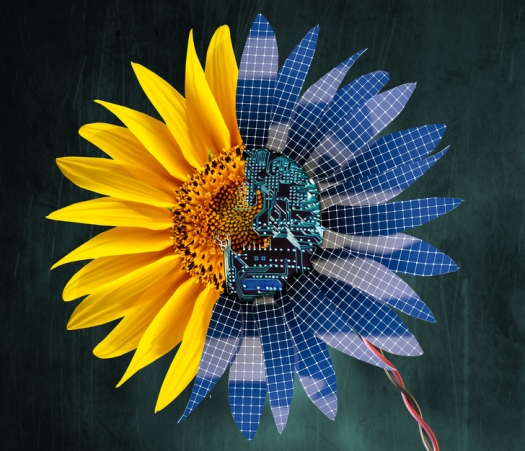Following the crystalline silicon solar-to-fuel roadmap

New analysis by MIT researchers points the way forward to optimising efficiency of an integrated system for harvesting sunlight to make storable fuel
Bringing the concept of an "artificial leaf" closer to reality, a team of researchers at MIT has published a detailed analysis of all the factors that could limit the efficiency of such a system.
The new analysis lays out a roadmap for a research program to improve the efficiency of these systems, and could quickly lead to the production of a practical, inexpensive and commercially viable prototype.
Such a system would use sunlight to produce a storable fuel, such as hydrogen, instead of electricity for immediate use. This fuel could then be used on demand to generate electricity through a fuel cell or other device. This process would liberate solar energy for use when the sun isn't shining, and open up a host of potential new applications.
The new work is described in a recent paper in the Proceedings of the National Academy of Sciences by associate professor of mechanical engineering Tonio Buonassisi, former MIT professor Daniel Nocera (now at Harvard University), MIT postdoc Mark Winkler (now at IBM) and former MIT graduate student Casandra Cox (now at Harvard).
It follows up on 2011 research that produced a "proof of concept" of an artificial leaf - a small device that, when placed in a container of water and exposed to sunlight, would produce bubbles of hydrogen and oxygen, as shown below.
The device combines two technologies: a standard silicon solar cell, which converts sunlight into electricity, and chemical catalysts applied to each side of the cell. Together, these would create an electrochemical device that uses an electric current to split atoms of hydrogen and oxygen from the water molecules surrounding them.
The goal is to produce an inexpensive, self-contained system that could be built from abundant materials. Nocera has long advocated such devices as a means of bringing electricity to billions of people, mostly in the developing world, who now have little or no access to it.
"What's significant is that this paper really describes all this technology that is known, and what to expect if we put it all together," Cox says. "It points out all the challenges, and then you can experimentally address each challenge separately."
Winkler adds that this is a "pretty robust analysis that looked at what's the best you could do with market-ready technology."
The original demonstration leaf, in 2011, had low efficiencies, converting less than 4.7 percent of sunlight into fuel, Buonassis explains. But the team's new analysis shows that efficiencies of 16 percent or more should now be possible using single-bandgap semiconductors, such as crystalline silicon.
"We were surprised, actually," Winkler says: Conventional wisdom held that the characteristics of silicon solar cells would severely limit their effectiveness in splitting water, but that turned out not to be the case. "You've just got to question the conventional wisdom sometimes," he says.
The key to obtaining high solar-to-fuel efficiencies is to combine the right solar cells and catalyst - a matchmaking activity best guided by a roadmap. The approach presented by the team allows for each component of the artificial leaf to be tested individually, then combined.
The voltage produced by a standard silicon solar cell, about 0.7 volts, is insufficient to power the water-splitting reaction, which needs more than 1.2 volts. One solution is to pair multiple solar cells in series. While this leads to some losses at the interface between the cells, it is a promising direction for the research, Buonassisi says.
An additional source of inefficiency is the water itself - the pathway that the electrons must traverse to complete the electrical circuit - which has resistance to the electrons, says. Buonassisi. So another way to improve efficiency would be to lower that resistance, perhaps by reducing the distance that ions must travel through the liquid.
"The solution resistance is challenging," Cox points out. But, she adds, there are "some tricks" that might help to reduce that resistance, such as reducing the distance between the two sides of the reaction by using interleaved plates.
"In our simulations, we have a framework to determine the limits of efficiency" that are possible with such a system, Buonassisi comments. For a system based on conventional silicon solar cells, he says, that limit is about 16 percent; for gallium arsenide cells, a widely touted alternative, the limit rises to 18 percent.
Models to determine the theoretical limits of a given system often lead researchers to pursue the development of new systems that approach those limits, Buonassisi says. "It's usually from these kinds of models that someone gets the courage to go ahead and make the improvements," he adds.
"Some of the most impactful papers are ones that identify a performance limit," notes Buonassisi. But, he adds that there's a "dose of humility" in looking back at some earlier projections for the limits of solar-cell efficiency: Some of those predicted "limits" have already been exceeded.
"We don't always get it right," acknowledges Buonassisi, but such an analysis "lays a roadmap for development and identifies a few "˜levers' that can be worked on."
This work was supported by the National Science Foundation, the Air Force Office of Scientific Research, the Singapore National Research Foundation through the Singapore-MIT Alliance for Research and Technology, and the Chesonis Family Foundation.

































